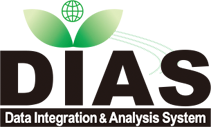Activities and Management Structure
Data Integration and Analysis System Program is upgrading and expanding DIAS while concurrently building a prototype workbench by which stakeholders from different disciplines can cooperate in integrating massive and diverse data and information to create new value. In a move toward the resolution of global-scale issues, the project also aims to design and deliver an application framework that can realize public benefit through the demonstration of sustained scientific excellence and its practical application.
1. Integration and expansion of infrastructure
1-1) Sophistication of software, improvement of infrastructure and storage capacity
1-2) Development of large-scale data access tools
2. Increasing volume of aggregated data
2-1) Satellite observation datasets
2-2) Global warming related datasets
2-3) Assimilated ocean data
2-4) In-situ observations, model re-analysis, assimilated model outputs
3. Expansion of data-sharing operations
3-1) Improving external access to data
3-2) Improving fusion of data from distributed systems
4. GEOSS interoperability
4-1) Sophistication of software, data analysis, visualization
4-2) Development of large-scale data imaging and analysis software
5. Promotion of ICSU data integration
- Improving the public value and applicability uof scientific knowledge
- Communal implementation of the DIAS pilot system
- Improving accessibility of national archived data thorugh document metadata enhancements
- GEOSS interoperability: data center integration and support
- ICSU data integration and promotion
- Coordinating project formation alongside international development assistance agencies
- Workbench evaluation and verification
- Long-term operaion, reference case compilation
- Coordination of working groups
- Hosting conferences for the presentation of research results
- Support for international activities
- Outreach activities
- Self-assessment activities
Member Institutions
Japan Agency for Marine-Earth Science and Technology(JAMSTEC) 
Kitami Institute of Technology 
Waseda University 
National Institute of Informatics (NII) 
The University of Tokyo 
Kyoto University 
Osaka Seikei University 
Kyushu University 
About the Global Environment Data Commons
The University of Tokyo established the Earth Observation Data Integration and Research Organization (EDITORIA) in April 2006 and reorganized it in April 2023 to establish the Global Environment Data Commons.
The Global Environment Data Commons is a collaborative effort among the university’s departments in the fields of earth observation, information science and technology, and public interest, such as disaster management and agriculture, to effectively utilize diverse and large volumes of earth observation data from heterogeneous sources to deepen understanding of the global environment, improve forecasting capabilities, and create information that contributes to sound policy making in crisis management, resource management, and other areas.
EDITORIA and the Global Environment Data Commons have commissioned for four terms the study on the Data Integration and Analysis System (DIAS) the Ministry of Education, Culture, Sports, Science and Technology (MEXT) had started in FY2006 as part of the National Basic Technology of the Third Science and Technology Basic Plan and have developed an empirical data system that integrates earth observation data effectively and efficiently and that fuses information. And they pioneered disseminating research results that have led to breakthroughs in understanding, predicting, and responding to global environmental changes, especially changes in the water cycle from the global scale to the river basin scale, and their impacts on water management systems and society.
Details here:
The Global Environment Data Commons



